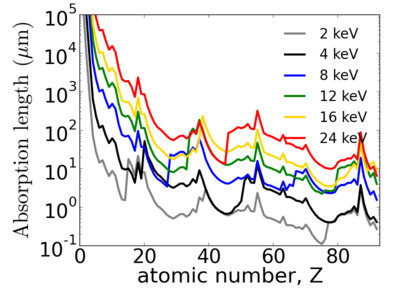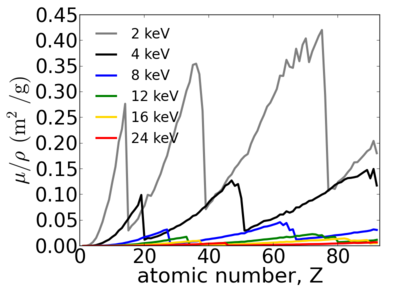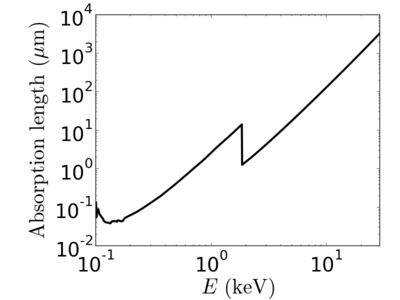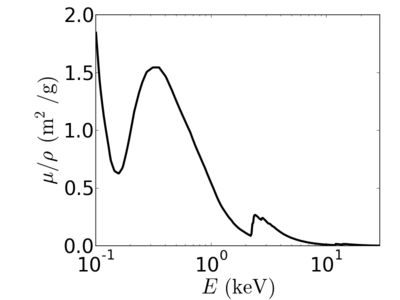|
|
| Line 24: |
Line 24: |
| | </math> | | </math> |
| | where ''ρ'' is density, ''N<sub>a</sub>'' is the Avogadro constant, and ''m<sub>a</sub>'' is the atomic molar mass. Note that the '''mass attenuation coefficient''' is simply <math>\mu/\rho</math>. | | where ''ρ'' is density, ''N<sub>a</sub>'' is the Avogadro constant, and ''m<sub>a</sub>'' is the atomic molar mass. Note that the '''mass attenuation coefficient''' is simply <math>\mu/\rho</math>. |
| | + | |
| | + | ==Elemental dependence== |
| | + | |
| | + | [[Image:Elements-abs.png|400px]][[Image:Elements-mu.png|400px]] |
| | | | |
| | ==Energy dependence== | | ==Energy dependence== |
Revision as of 11:25, 9 June 2014
The absorption length or attenuation length in x-ray scattering is the distance over which the x-ray beam is absorbed. By convention, the absorption length ϵ is defined as the distance into a material where the beam flux has dropped to 1/e of its incident flux.
Absorption
The absorption follows a simple Beer-Lambert law:

The attenuation coefficient (or absorption coefficient) is simply the inverse of the absorption length; 

Calculating
The absorption length arises from the imaginary part of the atomic scattering factor, f2. It is closely related to the absorption cross-section, and the mass absorption coefficient. Specifically, the atomic photoabsorption cross-section can be computed via:

Where λ is the x-ray wavelength, and re is the classical electron radius. The attenuation coefficient is given by:

where ρ is density, Na is the Avogadro constant, and ma is the atomic molar mass. Note that the mass attenuation coefficient is simply  .
.
Elemental dependence


Energy dependence
Notice that the absorption undergoes sharp increases when passing through an absorption edge.
Examples




Related forms
As can be seen, there are many related quantities which express the material's absorption:
- Absorption length
 , the distance over which the intensity falls to 1/e.
, the distance over which the intensity falls to 1/e.
- Attenuation coefficient
 , the characteristic inverse-distance for attenuation.
, the characteristic inverse-distance for attenuation.
- Mass attenuation coefficient
 , the density-scaled attenuation.
, the density-scaled attenuation.
- Absorptive atomic scattering factor
 , the intrinsic dissipative interaction of the material.
, the intrinsic dissipative interaction of the material.
- Atomic photoabsorption cross-section
 , the cross-section ('effective size') of the atom's x-ray absorption (capture) efficiency.
, the cross-section ('effective size') of the atom's x-ray absorption (capture) efficiency.
- Imaginary refractive index
 , the resonant component of the refractive index.
, the resonant component of the refractive index.
- Imaginary Scattering Length Density
 , the absorptive component of the scattering contrast.
, the absorptive component of the scattering contrast.

|

|

|

|

|

|

|

|

|

|

|

|

|

|

|

|

|

|

|

|

|

|

|

|

|

|

|

|

|

|

|

|

|

|

|

|

|

|

|

|

|

|

|

|

|

|

|

|

|
See Also

























































